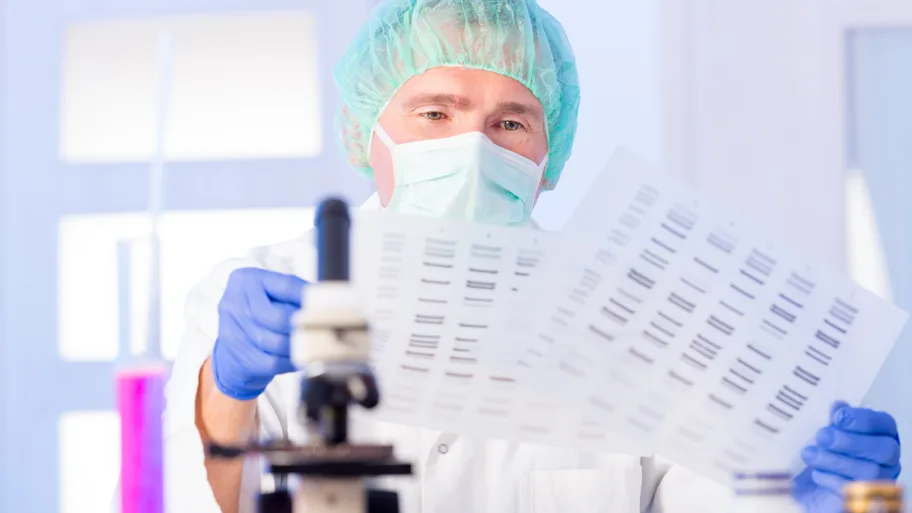
- Science News
- Featured news
- A new vision for genomics in animal agriculture
A new vision for genomics in animal agriculture

Researchers recommend prioritizing studies that help livestock producers – particularly in the pork, beef, poultry and aquaculture industries – more accurately predict how their operations will perform based on a range of variables. Image: Shutterstock.
The USDA blueprint predicts genomic technologies will play an increasingly central role in global livestock production
— by Iowa State University
Iowa State University researchers are part of a team that designed a new vision for animal genomics research into the next decade. The blueprint they created could help scientists and farmers meet the needs of a growing global population while improving livestock welfare and production.
The blueprint, published in Frontiers in Genetics, drew on insight from personnel at the U.S. Department of Agriculture, Iowa State and other institutions to identify areas of inquiry where USDA should direct research funds through 2027 concerning animal genomics, or the study of an organism’s full set of DNA. The research priorities outlined in the document have the potential to improve efficiency in animal agriculture, said James Reecy, ISU associate vice president for research and a professor of animal science.
Genome to Phenome: Improving Animal Health, Production, and Well-Being – A New USDA Blueprint for Animal Genome Research 2018–2027
Download original article (pdf)
Reecy, who co-authored the new blueprint, said the effort updates an earlier document that set the tone for genomics research during the previous decade. That effort also relied on ISU expertise.
The blueprint was developed during two Maryland workshops that drew leading animal genomics scientists from the U.S. and Canada. Their work product will guide how USDA funds research internally through its Agriculture Research Service, and externally through its National Institute of Food and Agriculture. Iowa State supported the workshops through a NIFA grant.
“In the grand scheme, what the group is advocating for are priorities that will move the livestock industry to meet the protein needs of the world going forward,” Reecy said.
Genomic technology took great strides in the last decade, but the blueprint calls for further progress that accounts for how other factors can work with genomics to improve production, he said. Future research should help livestock producers – particularly in the pork, beef, poultry and aquaculture industries – more accurately predict how their operations will perform based on a range of variables.
“We want to predict how environmental variation and management practices affect production as well,” he said. “We want to know how genotype, production and environment interact with one another. That’s the next step.”
The blueprint predicts genomic technologies will play an increasingly central role in global livestock production.
“Ultimately, animal genome technologies will become part of mainstream agricultural production strategies used to improve animal health, well-being, production efficiency and product quality in ways that meet the demands of growing global populations,” the document concludes.
Related: Edible insects? Lab-grown meat? The real future food is lab-grown insect meat
ISU involvement
Iowa State’s role in guiding animal genomics research dates back to National Research Sponsored Program 8, an effort to coordinate genomic research that led to the first USDA blueprint from 2008 to 2017. Max Rothschild, a Distinguished Professor of animal science and Ensminger Endowed Chair of International Agriculture, was a founding coordinating member of National Research Sponsored Program 8.
ISU scientists from a range of disciplines have turned their attention to transferring some of the innovations made in crop genomics to livestock. The ISU Office of the Vice President for Research launched an initiative to bring together interdisciplinary researchers at Iowa State to address precision livestock farming, which will lean heavily on breakthroughs in animal genomics. Iowa State hosted a precision livestock farming workshop last December that gathered some of the world’s leading experts in the field.
Reecy said ISU scientists are studying innovative sensors and bioinformatics technology that could have new uses in animal agriculture, health and food science. All of this work points toward a new frontier for livestock producers. Advances will allow them to choose production methods that work in concert with animal genomics and environmental factors to improve productivity, animal welfare and reliability while also leading to better products for consumers.
“We want livestock production to become a truly predictive science,” Reecy said.
Original article: Genome to Phenome: Improving Animal Health, Production, and Well-Being – A New USDA Blueprint for Animal Genome Research 2018–2027
REPUBLISHING GUIDELINES: Open access and sharing research is part of Frontiers’ mission. Unless otherwise noted, you can republish articles posted in the Frontiers news blog — as long as you include a link back to the original research. Selling the articles is not allowed.






